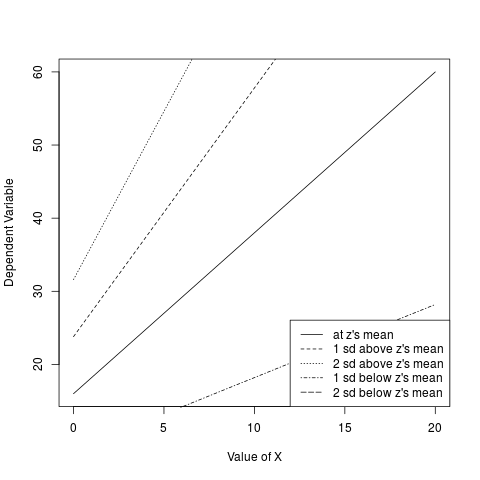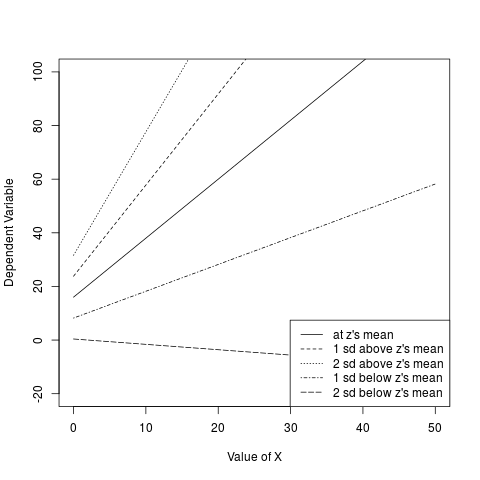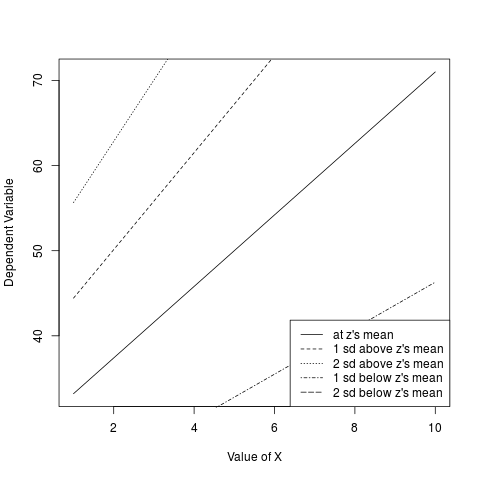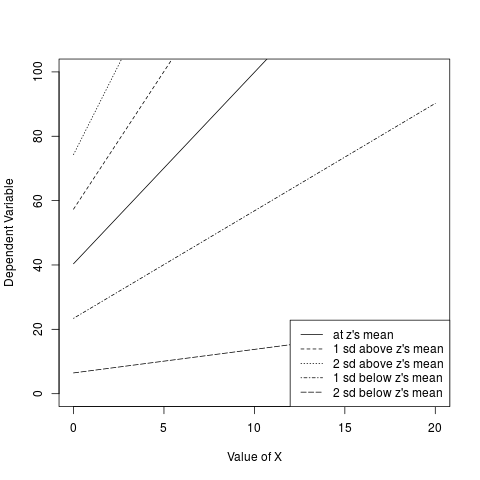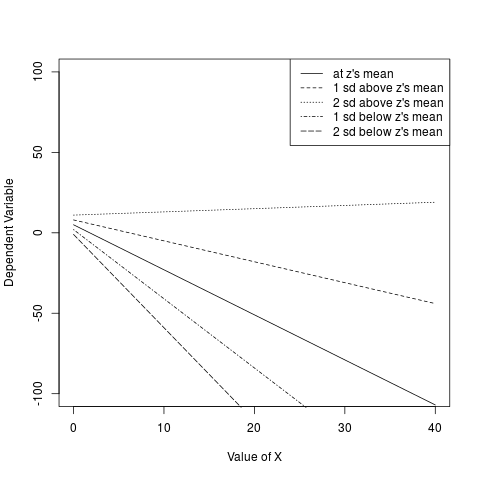Supported by Dr. Osamu Ogasawara and  providing providing  . . |
|
Last data update: 2014.03.03 |
Plotting Conditional Regression Lines with Interactions in Two DimensionsDescriptionTo plot regression lines for one two-way interactions, holding one of the predictors (in this function, z) at values -2, -1, 0, 1, and 2 standard deviations above the mean. Usageintr.plot.2d(b.0, b.x, b.z, b.xz,x.min=NULL, x.max=NULL, x=NULL, n.x=50, mean.z=NULL, sd.z=NULL, z=NULL,xlab="Value of X", ylab="Dependent Variable", sd.plot=TRUE, sd2.plot=TRUE, sd_1.plot=TRUE, sd_2.plot=TRUE, type.sd=2, type.sd2=3, type.sd_1=4, type.sd_2=5, legend.pos="bottomright", legend.on=TRUE, ... ) Arguments
DetailsTo input the predictor x, one can use either the limits of x ( NoteSometimes some of the regression lines are outside the default scope of the coordinates and thus cannot be seen; in such situations, one needs to, by entering additional arguments, adjust the scope to let proper sections of regression lines be seen. Refer to examples below for more details. Author(s)Keke Lai, Ken Kelley (University of Notre Dame; KKelley@ND.Edu) ReferencesCohen, J., Cohen, P., West, S. G. and Aiken, L. S. (2003). Applied multiple regression/correlation analysis for the behavioral sciences (3rd ed.). Mahwah, NJ: Erlbaum. See Also
Examples## A situation where one regression line is outside the default scope of the coordinates intr.plot.2d(b.0=16, b.x=2.2, b.z=2.6, b.xz=.4, x.min=0, x.max=20, mean.z=0, sd.z=3) ## Adjust the scope of x and y axes so that proper sections of regression lines can be seen intr.plot.2d(b.0=16, b.x=2.2, b.z=2.6, b.xz=.4, x.min=0, x.max=50, mean.z=0, sd.z=3, xlim=c(0,50), ylim=c(-20,100) ) ## Use specific vector(s) to define the predictor(s) intr.plot.2d(b.0=16, b.x=2.2, b.z=2.6, b.xz=.4, x=c(1:10), z=c(0,2,4,6,8,10)) intr.plot.2d(b.0=16, b.x=2.2, b.z=2.6, b.xz=.4, x.min=0, x.max=20, z=c(1,3,6,7,9,13,16,20), ylim=c(0,100)) ## Change the position of the legend so that it does not block regression lines intr.plot.2d(b.0=10, b.x=-.3, b.z=1, b.xz=.5, x.min=0, x.max=40, mean.z=-5, sd.z=3, ylim=c(-100,100),legend.pos="topright" ) Results
R version 3.3.1 (2016-06-21) -- "Bug in Your Hair"
Copyright (C) 2016 The R Foundation for Statistical Computing
Platform: x86_64-pc-linux-gnu (64-bit)
R is free software and comes with ABSOLUTELY NO WARRANTY.
You are welcome to redistribute it under certain conditions.
Type 'license()' or 'licence()' for distribution details.
R is a collaborative project with many contributors.
Type 'contributors()' for more information and
'citation()' on how to cite R or R packages in publications.
Type 'demo()' for some demos, 'help()' for on-line help, or
'help.start()' for an HTML browser interface to help.
Type 'q()' to quit R.
> library(MBESS)
> png(filename="/home/ddbj/snapshot/RGM3/R_CC/result/MBESS/intr.plot.2d.Rd_%03d_medium.png", width=480, height=480)
> ### Name: intr.plot.2d
> ### Title: Plotting Conditional Regression Lines with Interactions in Two
> ### Dimensions
> ### Aliases: intr.plot.2d
> ### Keywords: regression
>
> ### ** Examples
>
> ## A situation where one regression line is outside the default scope of the coordinates
> intr.plot.2d(b.0=16, b.x=2.2, b.z=2.6, b.xz=.4, x.min=0, x.max=20, mean.z=0, sd.z=3)
>
> ## Adjust the scope of x and y axes so that proper sections of regression lines can be seen
> intr.plot.2d(b.0=16, b.x=2.2, b.z=2.6, b.xz=.4, x.min=0, x.max=50, mean.z=0,
+ sd.z=3, xlim=c(0,50), ylim=c(-20,100) )
>
> ## Use specific vector(s) to define the predictor(s)
> intr.plot.2d(b.0=16, b.x=2.2, b.z=2.6, b.xz=.4, x=c(1:10), z=c(0,2,4,6,8,10))
>
> intr.plot.2d(b.0=16, b.x=2.2, b.z=2.6, b.xz=.4, x.min=0, x.max=20,
+ z=c(1,3,6,7,9,13,16,20), ylim=c(0,100))
>
> ## Change the position of the legend so that it does not block regression lines
> intr.plot.2d(b.0=10, b.x=-.3, b.z=1, b.xz=.5, x.min=0, x.max=40, mean.z=-5, sd.z=3,
+ ylim=c(-100,100),legend.pos="topright" )
>
>
>
>
>
>
> dev.off()
null device
1
>
|
